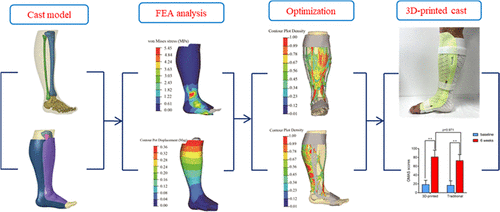Our official English website, www.x-mol.net, welcomes your feedback! (Note: you will need to create a separate account there.)
Customized Three-Dimensional-Printed Orthopedic Close Contact Casts for the Treatment of Stable Ankle Fractures: Finite Element Analysis and a Pilot Study
ACS Omega ( IF 4.1 ) Pub Date : 2021-01-24 , DOI: 10.1021/acsomega.0c06031 Pengcheng Lu 1, 2 , Zhengwen Liao 1, 2 , Qing Zeng 1, 2 , Huan Chen 1, 2 , Weichun Huang 3 , Zhen Liu 4 , Yanjun Chen 5 , Jing Zhong 6 , Guozhi Huang 1, 2
ACS Omega ( IF 4.1 ) Pub Date : 2021-01-24 , DOI: 10.1021/acsomega.0c06031 Pengcheng Lu 1, 2 , Zhengwen Liao 1, 2 , Qing Zeng 1, 2 , Huan Chen 1, 2 , Weichun Huang 3 , Zhen Liu 4 , Yanjun Chen 5 , Jing Zhong 6 , Guozhi Huang 1, 2
Affiliation

|
Ankle fracture is one of the most common traumatic fractures among the elderly population. The majority of ankle fractures are stable types with the typically conservative strategy of close contact casting treatment. The continuous use of unventilated standard cast immobilization severely affects patient’s satisfaction and compliance and markedly increases the rates of various complications. Three-dimensional (3D) printing for casts has advantages of lightweight, ventilated, proper-fit, and esthetic improvements. In this work, this novel 3D-printed cast has been applied to individuals with stable ankle fractures, and its effectiveness can be successfully validated with finite element analysis and a pilot study. A 30% reduction of the volume was chosen as the optimal result in topology optimization. Both 3D-printed casts and conventional casts showed significant ankle function improvement after immobilization for 6 weeks (p = 0.000). The 3D-printed casts were superior to the traditional casts in Olerud–Molander Ankle Scores (OMAS), with the mean difference of 8.3 ± 8.57 OMAS points (95% CI −10.8 to 27.5; p = 0.354) for 6 weeks, implying that the 3D-printed casts possibly maintain the equal clinical efficacy as the traditional casts. The statistically significant difference between groups from the 3D-printed cast and the traditional one observed in C-QUEST 2.0 was 11.3 ± 1.5 points (95% CI 8.0–14.6; p = 0.000), indicating that the 3D-printed cast possesses outperforming satisfaction and compliance and has great potential in practical applications. There were no severe complications in the 3D-printed casts, but more moderate complications were observed in the traditional casts.
中文翻译:

定制的三维印刷骨科紧密接触式铸件,用于治疗稳定的踝部骨折:有限元分析和初步研究
踝关节骨折是老年人群中最常见的创伤性骨折之一。大多数踝部骨折都是稳定型,通常采用保守接触铸造治疗的保守策略。持续使用不通风的标准石膏固定装置会严重影响患者的满意度和依从性,并显着增加各种并发症的发生率。铸件的三维(3D)打印具有轻巧,通风,合适和美观方面的优势。在这项工作中,这种新颖的3D打印铸件已应用于稳定的踝部骨折患者,其有效性可以通过有限元分析和初步研究得到成功验证。选择减少30%的体积作为拓扑优化的最佳结果。p = 0.000)。3D打印的演员在Olerud-Molander踝关节评分(OMAS)方面优于传统演员,连续6周的平均差异为8.3±8.57 OMAS点(95%CI -10.8至27.5;p = 0.354)。 3D打印的演员可能会保持与传统演员相同的临床疗效。从3D打印的铸件到C-QUEST 2.0中观察到的传统铸件之间的组之间的统计学显着性差异为11.3±1.5分(95%CI 8.0-14.6;p = 0.000),表明3D打印的铸件具有超强的满意度和合规性,在实际应用中具有巨大潜力。在3D打印的演员表中没有严重的并发症,但在传统演员表中观察到了中等程度的并发症。
更新日期:2021-02-02
中文翻译:

定制的三维印刷骨科紧密接触式铸件,用于治疗稳定的踝部骨折:有限元分析和初步研究
踝关节骨折是老年人群中最常见的创伤性骨折之一。大多数踝部骨折都是稳定型,通常采用保守接触铸造治疗的保守策略。持续使用不通风的标准石膏固定装置会严重影响患者的满意度和依从性,并显着增加各种并发症的发生率。铸件的三维(3D)打印具有轻巧,通风,合适和美观方面的优势。在这项工作中,这种新颖的3D打印铸件已应用于稳定的踝部骨折患者,其有效性可以通过有限元分析和初步研究得到成功验证。选择减少30%的体积作为拓扑优化的最佳结果。p = 0.000)。3D打印的演员在Olerud-Molander踝关节评分(OMAS)方面优于传统演员,连续6周的平均差异为8.3±8.57 OMAS点(95%CI -10.8至27.5;p = 0.354)。 3D打印的演员可能会保持与传统演员相同的临床疗效。从3D打印的铸件到C-QUEST 2.0中观察到的传统铸件之间的组之间的统计学显着性差异为11.3±1.5分(95%CI 8.0-14.6;p = 0.000),表明3D打印的铸件具有超强的满意度和合规性,在实际应用中具有巨大潜力。在3D打印的演员表中没有严重的并发症,但在传统演员表中观察到了中等程度的并发症。

























 京公网安备 11010802027423号
京公网安备 11010802027423号